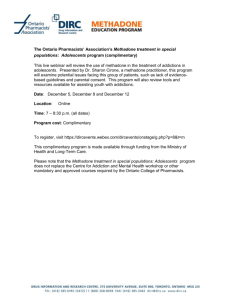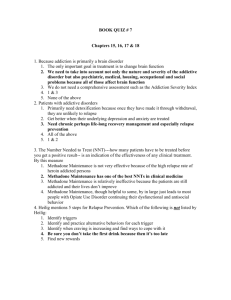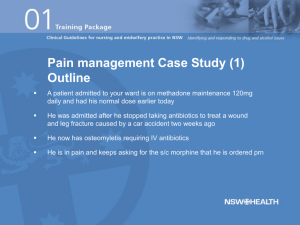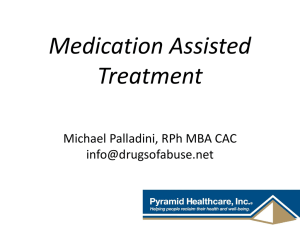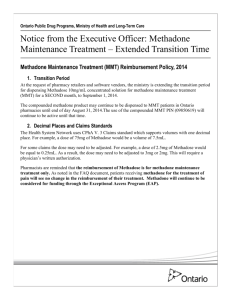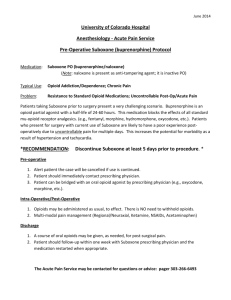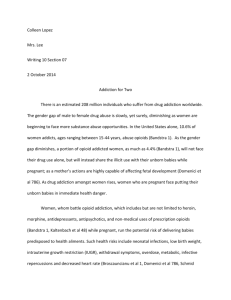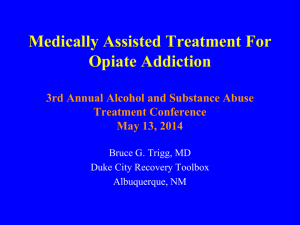Medication Assisted Treatment for Opioid Addiction
advertisement
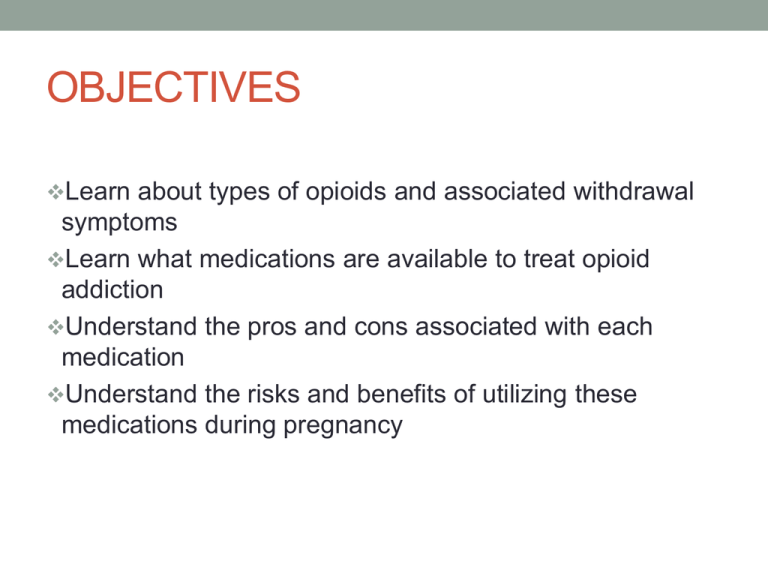
OBJECTIVES Learn about types of opioids and associated withdrawal symptoms Learn what medications are available to treat opioid addiction Understand the pros and cons associated with each medication Understand the risks and benefits of utilizing these medications during pregnancy MAT and Pregnancy Substance Abuse lifestyle Concern for mother - fetus - and - neonate • High rates of smoking, other drug use, depression, • • • • • • anxiety, PTSD among mothers High rates of dysfunctional families, abusive partners Lack of social supports Often financially struggling Poor coping and parenting skills Legal problems Unemployment, lack of job skills Potential medical complications in pregnant opioid using females and the fetus • HIV, Hepatitis C, STDs, seizures • Gestational diabetes, preeclampsia and eclampsia • Spontaneous abortion • Intrauterine Growth Retardation • Placental abruption • Premature rupture of membranes and labor • Placental insufficiency • Postpartum hemorrhage Methadone & Pregnancy • Methadone has been used to treat pregnant opiate addicts for nearly 40 years. • While relatively safe, not completely without risk. • Minimizing risk includes: • comprehensive assessment • education with family and patient regarding risks/benefits • providing medical supervision to decrease/eliminate illicit drugs of abuse. • Well metabolized and well tolerated BENEFITS OF MAT IN PREGNANCY IN A CLINICAL SETTING • Assist women in remaining free of illicit drugs, by • • • • preventing opiate withdrawal and cravings. Assist in eliminating criminal activity and other high risk behaviors that may be harmful. Increase probability of access to prenatal care. Allow for substance abuse education and therapy in a structured setting Methadone’s long half-life (24 to 36 hours) and how it is monitored and controlled BENEFITS OF MAT IN PREGNANCY IN A CLINICAL SETTING, cont. • Breastfeeding is possible and often preferable for most women on MAT (minimal amount of methadone found in breast milk) • Decrease risk to fetus of infection of HIV, Hepatitis and Sexually Transmitted Diseases • Decrease the possibility of fetal death by stabilizing the intrauterine environment from fluctuations associated with abstinence syndrome Potential Risks • Neonatal Methadone Abstinence Syndrome. Similar to that of heroin, often longer lasting • In-utero exposure to methadone may lead to low birth weight. (Many patients also smoke—uncertain which causes the low weight) • Onset of withdraw can be delayed for several hours to two weeks. • The maternal dose vs. NAS severity is the subject of some debate. • Seizures can be seen in a minority of babies. Although some MDs attribute this to the use of benzodiazepines during pregnancy. Potential Risks, cont. • Thrombocytosis • Hyperthyroid State elevation of T3 and T4 during the first week of life • SIDS: when controlled for other high-risk variables SIDS is about 3-4 times higher in opiate exposed infants. • Often, doses need to be increased. • Pregnant women may feel they can stay on MMT regardless of other drug use until delivery. Potential Methadone draw-backs • NAS • Not always available • Stigma • Daily visits (difficult with rural populations) • Treatment services often quite variable so outcomes can be quite variable Potential Neonatal complications • Premature birth • Low birth weight and small for gestational age • Microcephaly • Meconium aspiration syndrome • Neonatal abstinence syndrome • SIDS • HIV infection Methadone Dosing During Pregnancy • Current consensus is 50-150 mg, with blood plasma levels ≥ 200 ng/ml • Same criteria for dose increases as with non-pregnant • May need to adjust dose upwards during pregnancy • Greater plasma volume • Increased renal blood flow Then what? Infant/child development • Difficult to control for just the effects of methadone vs. other drugs of abuse/genetic problems, etc • Head circumference normalizes by preschool (Lifshitz, 1985) • Neurological development assessed by Bayley Scales of Infant Development within normal limits (Patso, 1989) • Poorer performance in fine and gross motor coordination, attention, language vs. controls (for review see: Chapt. 20 of Strain and Stitzer, The Treatment of Opioid Dependence, 2006 and Helmbrecht 2008) Factors influencing long-term outcomes of methadone exposed children • Effects of poverty • Effects of other drugs of abuse (including nicotine and alcohol) • Effects of environments (supports, opportunities) • Caregiver quality and infant, child, young adult resilience NARCOTIC ADDICTION PROGRAM’S TREATMENT PROTOCOL • Pregnant woman contacts the clinic. • She is assessed for appropriateness on the phone and then comes in for a face to face assessment. • Once deemed appropriate, “patient” is then admitted to hospital for prenatal assessment and induction to methadone. • She will stay in the hospital for 5-7 days and is typically discharged on 30 to 40mg of methadone. • Upon discharge from hospital, patient will come to MAT clinic and have a psychiatric assessment by the physician. NARCOTIC ADDICTION PROGRAM’S TREATMENT PROTOCOL • Patient will then go for up to 30 days of residential substance abuse treatment—she will get her methadone dose there. • Upon completion of residential substance abuse treatment, patient will begin daily dosing in the clinic, meet with her therapist once a week, and submit to random drug screens. • It is recommended, when appropriate, the patient continue residential long-term treatment. Post Delivery Issues • Neonatal Abstinence (Finnegan Scale) • “Look what you’ve done to your baby” attitude by hospital • • • • • • • staff and family members Pain management issues Dose adjustment/regulation Confidentiality in the hospital: Drs. and nurses must not discuss methadone in the presence of anyone other than the patient Support Network: Often limited—needs to attend 12-step meetings, church, self-help groups, etc. Increased risk of relapse Post-Partum depression Now what?—work on parenting issues, relationship with baby’s father, family of origin, friendships, life issues… Breastfeeding on Methadone • American Academy of Pediatrics and the World Health Organization’s Working Group on Human Lactation approves breastfeeding among women on methadone Vincent Dole: “Some people became overly converted. They felt, without reading our reports carefully, that all they had to do was give methadone and then there was no more problem with the addict…I urged physicians should see that the problem was one of rehabilitating people with a very complicated problem and that they ought to tailor their programs to the kinds of problems they were dealing with. . .The stupidity of thinking that just giving methadone will solve a complicated social problem seems to me beyond comprehension (Courtwright, 1989, p 338)” Other Options • Development of Subutex®/Suboxone® • Suboxone (buprenorphine/naloxone) • Suboxone contains four parts buprenorphine and one part naloxone. • Naloxone was added to in an effort to dissuade patients from injecting the tablets. • Subutex (buprenorphine) • Subutex contains only buprenorphine. • U.S. FDA approved Subutex® and Suboxone® sublingual strips1 for opioid addiction treatment on October 8, 2002. • Product launched in U.S. in March 2003 • Interim rule changes to federal regulation (42 CFR Part 8) on May 22, 2003 enabled Opioid Treatment Programs (specialist clinics) to offer buprenorphine. Buprenorphine aka Subutex • • • • • • • • Initially used as an analgesic (but not in sublingual form) Has been used in France for over a decade for opioid addiction Use buprenorphine without naloxone in pregnancy Schedule III pain medication (Buprenex) Approved in 2002 for outpatient treatment of opiate addiction. Partial opiate agonist (sublingual tablet) Only approved M.D.’s can prescribe Subutex/Suboxone. Most have no affiliation with, or background in treating addiction. Administered as sublingual strip • Subutex- 2 mg or 8 mg buprenorphine BUPRENORPHINE (Subutex) BENEFITS Virtually no euphoric or tranquilizing effects unless opiate naive. Blocks effects of other opiates. Relieves cravings to use other opiates. Allows “normal function”. Lower abuse liability and diversion potential than Methadone. Increased anonymity and less intrusive, vs. attending a MAT clinic daily. Increased treatment options/access to treatment. Decrease in high-risk behaviors. Good “step down” option for those tapering from Methadone. BUPRENORPHINE (Subutex) LIMITATIONS Expensive. Cannot take if opiates still in your system. Counseling may not be available or affordable in the same area as doctor. Not enough certified doctors or doctors willing to treat. No regulations for physician office, only “practice guidelines”. Potential for overdose of other opiates due to ceiling effect. Abuse and diversion potential still exists Buprenorphine/naloxone aka Suboxone Naloxone (Narcan) added as means to decrease diversion. Poor bioavailability sublingually, but if dissolved and injected, will precipitate withdrawal. Reduced abuse potential. Suboxone- 2 mg bup + .5 mg naloxone 8 mg bup + 2 mg naloxone Buprenorphine breastfeeding • Does get into breast milk • Poor oral bioavailability • No reports of NAS when women acutely stop taking buprenorphine while breastfeeding Neonatal Abstinence Syndrome (NAS) CNS excitability (hyperactivity, irritability, sleep disturbance) Autonomic Nervous System (fever, sweating, nasal stuffiness) Gastrointestinal dysfunction (uncoordinated sucking/swallowing, vomiting, loose stools) Respiratory Distress (increased respiratory rate, bluish color around the mouth, nasal flaring) NAS Predictability • Can happen with any opioid (heroin, oxycontin, • • • • methadone, etc.) Not clearly related to methadone dose in mother May occur less often with buprenorphine Contribution of genetics, other drugs Smoking and vagal tone have been associated with NAS NAS Treatment • Pharmacotherapies used to reduce withdrawal symptoms include: • Phenobarbital • Morphine • Methadone • Tincture of Opium • Non-pharmacologic supportive care • Decrease sensory inputs • Stabilize environment • Help parents have realistic expectations (babies are not addicted) Summary Opioid addiction and pregnancy • The substance abusing lifestyle brings concerns for • • • • mother, fetus and neonate. Although there are risks, Medication Assisted Treatment (MAT) provides benefits to the opiate addicted pregnant woman. Methadone maintenance is still the treatment of choice and standard of care in the US. Buprenorphine treatment is possible, evidence still lacking. Detoxification is contraindicated unless done in hospital with monitoring.
